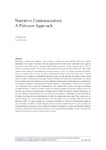Mostrar o rexistro simple do ítem
Narrative Communication. A Peircean Approach
| dc.contributor.author | Lee, Yunhee | es_ES |
| dc.date.accessioned | 2014-10-02T12:31:54Z | |
| dc.date.available | 2014-10-02T12:31:54Z | |
| dc.date.issued | 2012 | es_ES |
| dc.identifier.citation | Culture of communication / Communication of culture, 2012: 1383-1394. ISBN: 978-84-9749-522-6 | es_ES |
| dc.identifier.isbn | 978-84-9749-522-6 | es_ES |
| dc.identifier.uri | http://hdl.handle.net/2183/13429 | |
| dc.description.abstract | [Abstract] This paper examines how narrative can function as medium of communication. There are various approaches to the study of narrative. Recent approaches have become more concerned with cognition and context than with narrative structure itself. These approaches provide enquirers with a view of narrative as potential medium for communication between the storyteller and the addressee. Particularly insofar as the concept of communication involves context, as well as a shared situation and opinion between communicators, the issue of what is communicated comes to be a focus. This aspect includes communicators themselves as important components along with the message for communication. Based on the concept of communication, the paper examines narrative as medium of communication by looking at the symbolic form of the narrative text to be transmitted. This requires interpreting activity incorporated with semiotic enterprise. At this point, the Peircean semiotic is a methodology to discover how symbolic text of narrative can be used for communication. This method has the great advantage of revealing the three domains of narrative: narrative structure as semiotic maneuver, narrative context as basis for cognition, and narrative communication as dialogic process. Within the Peircean semiotic framework, not only the concept of communication but also the concept of narrative is redefined, in which the definition of narrative is extended to the representation of reality for constructing knowledge. Thus, narrative is not limited to fiction, but it also includes narrative in life. This study focuses on narrative discourse in art by analyzing a film. The study suggests four conditions of narrative to become a communication medium: first, fictionality as narrative’s sense based on firstness; second, temporal-spatial structure as narrative’s meaning based on secondness; third, symbolic representation as narrative’s significance based on thirdness; and fourth, combination of these three to produce a final opinion through dialogic process. This study will contribute to the advancement of communication studies. | es_ES |
| dc.language.iso | eng | es_ES |
| dc.publisher | Universidade da Coruña | es_ES |
| dc.title | Narrative Communication. A Peircean Approach | es_ES |
| dc.type | info:eu-repo/semantics/conferenceObject | es_ES |
| dc.rights.access | info:eu-repo/semantics/openAccess | es_ES |






